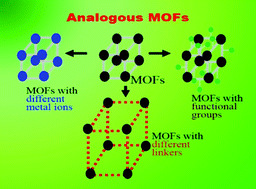Analogous porous metal–organic frameworks: synthesis, stability and application in adsorption
Abstract
So far, a huge number of metal–organic frameworks (MOFs) have been synthesized and studied very widely for various applications like gas

* Corresponding authors
a
Department of Chemistry and Green-Nano Materials Research Center, Kyungpook National University, Daegu, Korea
E-mail:
sung@knu.ac.kr
Fax: 82-53-950-6330
So far, a huge number of metal–organic frameworks (MOFs) have been synthesized and studied very widely for various applications like gas

 Please wait while we load your content...
Something went wrong. Try again?
Please wait while we load your content...
Something went wrong. Try again?
S. H. Jhung, N. A. Khan and Z. Hasan, CrystEngComm, 2012, 14, 7099 DOI: 10.1039/C2CE25760B
To request permission to reproduce material from this article, please go to the Copyright Clearance Center request page.
If you are an author contributing to an RSC publication, you do not need to request permission provided correct acknowledgement is given.
If you are the author of this article, you do not need to request permission to reproduce figures and diagrams provided correct acknowledgement is given. If you want to reproduce the whole article in a third-party publication (excluding your thesis/dissertation for which permission is not required) please go to the Copyright Clearance Center request page.
Read more about how to correctly acknowledge RSC content.
 Fetching data from CrossRef.
Fetching data from CrossRef.
This may take some time to load.
Loading related content
